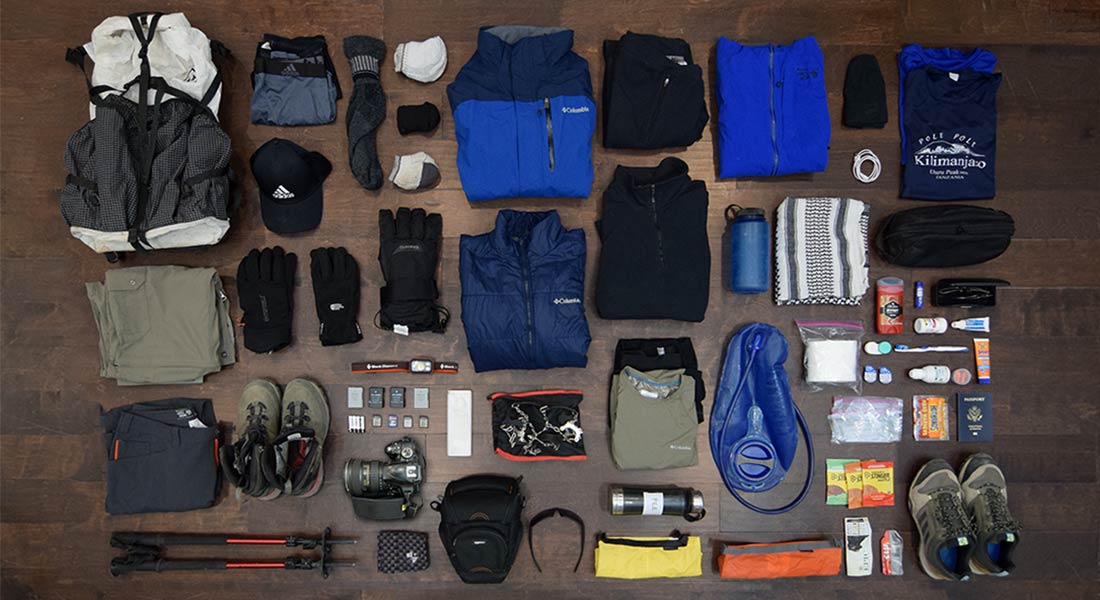In this post, we are going to discuss what to wear on Kilimanjaro. Kilimanjaro is made up of five distinct climate zones. Keep this in mind as you pack for your climb. The trail starts fairly low, depending on the route, anywhere from 5,400-9,800 feet. They all start in the warm cultivation zone. It quickly ascends to a more humid, wet rainforest. After you exit the rainforest, your trek continues in a warm, mostly arid Heather/Moorland zone. However, this zone can be quite cold at night. Above that, you’ll trek through the Alpine desert, which can be warm during the day, but below freezing at night. And finally, you’ll be in the potentially cold, snowy, windy summit zone. So how do you prepare your clothing for such a large temperature range? Below are Kilimanjaro Sunrise’s recommendations for how to dress to accommodate these varying degrees of weather and temperatures.
Examples of clothing for Kilimanjaro
Layering your Clothes
Layering is the best way of regulating your body temperature. A minimum layer system consists of three different layers. Each layer serves its own purpose. These layers include a base layer, mid-layer, and outer layer. Below is a minimum required clothing list. You’ll want to adjust the number of t-shirts, socks, underwear, etc. depending on the number of days on the mountain.
Base Layer
The base layer’s function is to keep your skin warm and dry. It does this by wicking away moisture from the skin as it develops. This layer usually consists of a semi-snug-fitting shirt such as an Under Armour type shirt or a Nike Dry Fit shirt and pants (pictured, above). You will want baselayers for both the top and bottom. Bring at least 2 pairs, one to sleep in and one for summit night.
Mid Layer
Your body naturally generates heat and the mid-layers function is to keep that warmth in. To do this you should wear a fleece (above), spandex/polyester blend pullover, or a softshell jacket (above). What you wear depends on the weather. This layer can be of varying thicknesses.
Outer Layer
The outer layer protects you from wind, cold, and rain. On Kilimanjaro, you will need to bring a full complement of rain gear – including a rain jacket (above) and rain or waterproof pants. A warm down or synthetic weatherproof jacket (above) is essential. Lastly, you can choose to bring gaiters to keep snow, moisture, and gravel out of your boots. If your pack is not waterproof, bring a pack cover.
Protect Your Head and Face
During your trek, you should wear something on your head while hiking. Headgear will protect your head from wind, sun, and cold. In the warm zones wear a cap or wide-brimmed hat. When it’s cold, wear a beanie (above). When choosing headwear, do not think “cute” think “warm”. You will also want to get a balaclava (above), shemagh (top), or scarf for your face to shield you from the elements.
Keep Your Extremities Warm
You are probably already aware of this, but your hands and feet are difficult to keep warm. The human body decreases the blood supply to your extremities the colder your body gets. Climbers should bring warm, windproof, and waterproof gloves (above) or mittens and waterproof boots. Additionally, bring several pairs of socks, and change them regularly. When you reach the camp, rinse them out and hang them over your tent to dry. Be sure to put them in your tent before the sun sets so they do not freeze. Don’t hang them in the tent vestibule to dry, the design of the tent wicks the condensation into the vestibule and will make the items wetter.
Kilimanjaro Gear Example
| Number | Quantity | Item | Description |
|---|---|---|---|
| 1 | 1 | 35 Liter pack | This is your day pack. It should also be used for your carry-on bag. It should have everything in it you need for the first few days on the mountain in case your checked bags are lost or delayed. |
| 2 | 3-4 | Dry weave underwear | Should be dry weave material to wick moisture away to avoid chafing. |
| 3 | 1 | Cap or a wide-brimmed hat | To keep the sun off |
| 4 | 3-4 | Variety of socks | liners, tall and short hiking socks |
| 5 | 1 | Shell* | Waterproof, windproof, and warm |
| 6 | 1 | Fleece pants | For warmth, a mid-layer. Can be worn under waterproof pants for summit night |
| 7 | 1 | Rain jacket | To keep you dry |
| 8 | 1 | Beanie | To keep your head warm. Fleece or wool |
| 9 | 1 | Charging cable | To charge your camera and phone |
| 10 | 2-4 | Short and long sleeve shirts | Dry weave |
| 11 | 1 | Convertible hiking pants | Removable leg bottoms to adjust for temperature. |
| 12 | 1 | Windproof gloves | For warmth and to protect from the wind |
| 13 | 1 | Fleece gloves | To wear around camp and under summit gloves if needed |
| 14 | 1 | Snowboard, ski, or mountaineer gloves | For summit night |
| 15 | 1 | Puffy, Puffer, Puff jacket | To insulate under the shell or worn separately |
| 16 | 1 | Fleece top | For warmth |
| 17 | 1 | Water bottle | Nalgene, Camelbak, Thermaflask type water bottle |
| 18 | 1 | Face and neck protection | Shemagh ( pictured), Balaclava, scarf |
| 19 | 1 | Toiletries bag | To carry your toiletries |
| 20 | 1 | Waterproof pants | For stopping rain, snow, and wind. |
| 21 | 1 | Gortex boots | Waterproof, broken-in, tall boots for the snow |
| 22 | 1 | Headlamp | To see at night and for summit night |
| 23 | 5+ | Batteries | Extra set for your headlamp and several for your camera(s) |
| 24 | 4+ | SD cards | Plenty of storage cards for your camera. Optional small portable HD for phone and camera storage. |
| 25 | 1 | Power bank | Power banks seem to work better than solar panels. Make sure it is at least 20000mAh so it lasts the entire climb |
| 26 | 1 | Microspikes | Optional, but good to have in case of icy trail. We will let you know if they are required at the trip briefing. |
| 27 | 2 | Baselayers | One pair to sleep in if you get cold easily and one for summit night. |
| 28 | 1 | Hydration bladder | Drink plenty of water. The hose and/or mouthpiece may freeze on summit night, put it inside your shirt or wrap it inside your daypack |
| 29 | 1 | Toilet paper and wipes | Put your TP in a gallon-size freezer bag so it stays dry. |
| 30 | – | Toiletries | Deodorant, eye care (extra contacts, saline, glasses, etc.) dental floss, toothpaste, toothbrush, medication, sunscreen, nail clippers, lip balm, earplugs |
| 31 | 2+ | Ziploc bags | Quart or gallon size bags to keep items dry. Single-use bags like grocery bags are illegal in Tanzania |
| 32 | 2+ | Hand warmers | Optional for summit night. They may or may not work due to the low oxygen levels |
| 33 | 1 | Passport | You can’t travel without it |
| 34 | 1 | Trekking Poles* | We recommend renting and using them, especially for the downhill |
| 35 | 1 | DSLR Camera | With an extra lens. How often do you travel to Africa? Take a ton of pictures |
| 36 | 1 | Buff | To protect your neck from sun, wind, and to wear in public |
| 37 | 1 | Camera bag | A holster bag works best for easy access to the camera |
| 38 | 1 | Sunglasses | To protect your eyes from the sun and wind |
| 39 | 1 | Pee bottle | So you can avoid leaving the tent overnight. Make sure to label it |
| 40 | 2+ | Dry bags | To organize and keep your items dry inside your duffle bag |
| 41 | 4+ | Snacks | Bring snacks you like for hiking: Trailmix, Energy bars, candy, beans, gels, waffles, etc. |
| 42 | 1 | Light hikers/running shoes | For lower elevation hiking and to wear around camp |
| Not Pictured | Quick-drying towel | To dry off with after washing up at camp | |
| Not Pictured | Sleeping bag and pad* | A sleeping bag can be rented and the sleeping pad is included in the climb price | |
Final Thoughts
In conclusion, these are all items the staff at Kilimanjaro Sunrise recommends. But it’s up to you to decide what you can live with and what you can’t. Just remember Mount Kilimanjaro is 19,341 feet tall. That is higher than Mount Everest base camp. Even though Mount Kilimanjaro is the most “walkable” mountain on Earth, it is still a harsh environment. Trekking on Kilimanjaro needs to be taken seriously. Knowing what to wear on Kilimanjaro is very important.
Finally, once you make the summit, you’ll have plenty of pictures to impress your friends with on social media.






